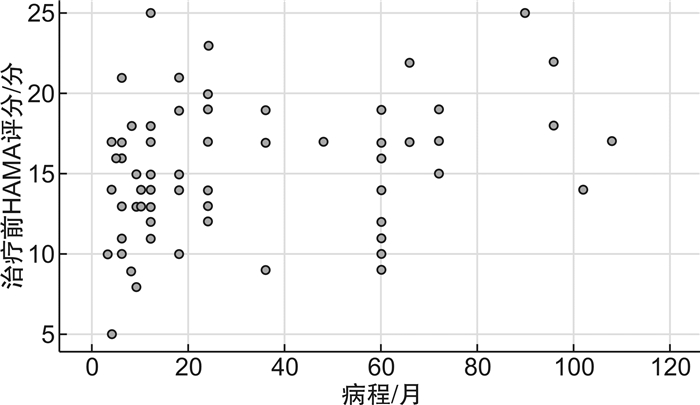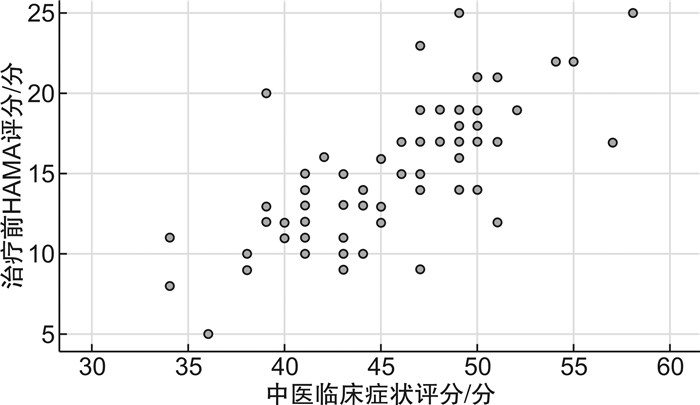Clinical study on Chaishao Tongjiang Prescription in treating non-erosive reflux disease with liver-stomach dissonance
-
摘要: 目的 研究柴芍通降方治疗肝胃不和证非糜烂性反流病(non-erosive reflux disease,NERD)患者的临床疗效。方法 选取2022年7—12月收治的74例NERD患者为研究对象,随机分为中药治疗组和西药对照组,每组各37例。中药治疗组予自拟柴芍通降方,对照组予雷贝拉唑钠肠溶片口服,总疗程均为8周。比较治疗前后两组患者的反流性疾病问卷(reflux disease questionnaire,RDQ)、中医临床症状评分问卷、胃食管反流病问卷(gastroesophageal reflux disease questionnaire,GerdQ)、生活质量评分、汉密尔顿焦虑量表(Hamilton anxiety scale,HAMA)及汉密尔顿抑郁量表(Hamilton depression scale,HAMD)评分等以评估疗效;治疗结束后1个月随访,以观察复发率。结果 经过治疗,中药治疗组患者的RDQ评分、中医临床症状评分、GerdQ评分、生活质量改善程度及焦虑状态缓解程度均高于西药对照组,差异有统计学意义(P < 0.05);随访结果表明,中药治疗组的复发率低于西药对照组,差异有统计学意义(P < 0.05)。结论 柴芍通降方治疗肝胃不和证NERD可缓解患者的临床症状,提高生活质量,在总体疗效、改善焦虑状态、防治复发等方面具有一定优势,值得临床推广应用。Abstract: Objective To study the clinical efficacy of Chaishao Tongjiang Prescription in the treatment of non-erosive reflux disease(NERD) with liver-stomach dissonance.Methods A total of 74 NERD patients admitted from July to December 2022 were selected as the research objects, and were randomly assigned to the Traditional Chinese Medicine treatment group and the Western Medicine control group, with 37 cases in each group. The Traditional Chinese Medicine treatment group was treated with self-made Chaishao Tongjiang Prescription. Rabeprazole sodium enteric-coated tablets were given orally in the control group, and the total course of treatment was eight weeks. Before and after treatment, the reflux disease questionnaire(RDQ), Traditional Chinese Medicine clinical symptom score questionnaire, gastroesophageal reflux disease questionnaire(GerdQ), quality of life score, Hamilton anxiety scale(HAMA) and Hamilton depression scale(HAMD) were compared between the two groups to evaluate the curative effect. The patients were followed up for one month after treatment to observe the recurrence rate.Results After treatment, the RDQ score, Traditional Chinese Medicine clinical symptom score, GerdQ score, quality of life improvement and anxiety relief of the Traditional Chinese Medicine treatment group were higher than those of the Western Medicine control group, and the differences were statistically significant(P < 0.05). Follow-up showed that the recurrence rate of the Traditional Chinese Medicine treatment group was lower than that of the Western Medicine control group, and the difference was statistically significant(P < 0.05).Conclusion Chaishao Tongjiang Prescription in the treatment of NERD syndrome of liver-stomach dissonance can relieve the clinical symptoms of patients and improve the quality of life. It has certain advantages in overall efficacy, improvement of anxiety state, prevention and treatment of relapse and so on, which is worthy of further clinical promotion.
-

-
表 1 两组患者的临床资料比较
例,X±S 组别 例数 性别 年龄/岁 病程/月 RDQ/分 中医症状评分/分 GerdQ/分 HAMA/分 HAMD/分 男 女 中药治疗组 36 12 24 49.50±12.50 30.92±29.94 27.64±4.28 45.94±4.85 12.53±1.93 15.11±3.75 9.25±4.20 西药对照组 35 14 21 49.80±13.10 27.74±27.05 26.74±5.20 45.06±5.39 12.00±1.97 15.00±4.39 9.09±3.98 t/χ2/Z 0.340 -0.099 -0.509 0.794 0.730 1.139 0.115 -0.069 P 0.560 0.922 0.611 0.430 0.468 0.259 0.909 0.945 表 2 治疗前后两组患者的RDQ积分比较
分,X±S 组别 例数 治疗前 治疗后 Z P 中药治疗组 36 27.64±4.28 6.31±5.02 -5.237 < 0.001 西药对照组 35 26.74±5.20 10.89±7.14 -5.163 < 0.001 t/Z 0.794 -3.038 P 0.783 0.002 表 3 两组患者治疗后的疗效比较
例(%) 组别 例数 痊愈 显效 有效 无效 总有效 中药治疗组 36 4(11.11) 16(44.44) 13(36.11) 3(8.33) 33(91.67)1) 西药对照组 35 2(5.71) 5(14.29) 17(48.57) 11(31.43) 24(68.57) 与西药对照组比较,1) P < 0.05。 表 4 治疗前后两组患者的中医临床症状总评分与主要症状评分比较
分,X±S 组别 例数 总评分 主要症状 反酸 烧心 胸骨后疼痛 胸胁胀满 嗳气 腹胀 中药治疗组 36 治疗前 45.94±4.85 7.92±1.78 5.39±1.05 3.50±1.94 4.44±1.28 5.67±0.76 4.94±1.22 治疗后 13.75±11.751)2) 2.33±2.501)2) 1.72±2.041)2) 0.94±1.551)2) 0.89±1.621)2) 1.50±1.381)2) 1.22±1.611)2) 西药对照组 35 治疗前 45.06±5.39 7.71±1.96 4.80±1.69 3.66±1.97 5.03±1.12 0.43±1.04 4.80±1.30 治疗后 25.63±12.921) 3.26±2.341) 1.94±1.911) 1.49±1.771) 2.69±2.061) 3.54±2.231) 2.57±1.911) 与本组治疗前比较,1) P < 0.05;与西药对照组治疗后比较,2) P < 0.05。 表 5 治疗前后两组患者的次要症状评分比较
分,X±S 组别 例数 纳差 恶心欲呕 情绪不畅 胸闷喜太息 咽喉梗阻感 吞咽困难 呛咳 心烦失眠 便秘 便溏 中药治疗组 36 治疗前 0.75±0.65 0.89±0.92 2.72±0.45 2.31±0.53 1.31±1.01 0.31±0.58 0.50±0.74 2.44±0.70 1.36±1.25 0.44±0.81 治疗后 0.47±0.611)2) 0.25±0.551) 1.06±0.831)2) 0.94±0.791)2) 0.56±0.701) 0.11±0.321) 0.06±0.231) 1.11±0.751)2) 0.56±0.701) 0.03±0.171)2) 西药对照组 35 治疗前 1.74±0.61 0.83±0.82 2.60±0.55 2.37±0.65 1.00±1.03 0.23±0.43 0.34±0.59 2.60±0.55 1.49±1.27 0.43±0.92 治疗后 1.20±0.581) 0.54±0.741) 2.06±0.841) 2.00±0.801) 0.77±0.841) 0.09±0.281) 0.14±0.491) 1.97±0.821) 1.06±1.111) 0.34±0.77 与本组治疗前比较,1) P < 0.05;与西药对照组治疗后比较,2) P < 0.05。 表 6 两组患者治疗前后的GerdQ积分及生活质量评分比较
分,X±S 组别 例数 GerdQ积分 生活质量评分 中药治疗组 36 治疗前 12.53±1.93 18.25±2.30 治疗后 4.58±3.451) 5.61±3.011)2) 西药对照组 35 治疗前 12.00±1.97 18.17±2.14 治疗后 5.60±3.831) 10.17±3.041) 与本组治疗前比较,1) P < 0.05;与西药对照组治疗后比较,2) P < 0.05。 表 7 两组患者治疗后的复发率比较
例(%) 组别 例数 有效 复发 未复发 中药治疗组 36 33(91.7) 5(15.2) 28(84.8) 西药对照组 35 24(68.6) 10(41.7) 14(58.3) 表 8 两组患者治疗前后的HAMA评分及HAMD评分比较
分,X±S 组别 例数 HAMA评分 HAMD评分 中药治疗组 36 治疗前 15.11±3.75 9.25±4.20 治疗后 9.67±3.931)2) 8.86±2.70 西药对照组 35 治疗前 15.00±4.39 9.09±3.98 治疗后 12.54±4.821) 9.20±2.96 与本组治疗前比较,1) P < 0.05;与西药对照组治疗后比较,2) P < 0.05。 -
[1] Tack J, Drossman DA. What's new in Rome Ⅳ?[J]. Neurogastroenterol Motil, 2017, 29(9): e13053. doi: 10.1111/nmo.13053
[2] El-Serag HB, Sweet S, Winchester CC, et al. Update on the epidemiology of gastro-oesophageal reflux disease: a systematic review[J]. Gut, 2014, 63(6): 871-880. doi: 10.1136/gutjnl-2012-304269
[3] Xiao YL, Zhou LY, Hou XH, et al. Chinese expert consensus on gastroesophageal reflux disease in 2020[J]. J Dig Dis, 2021, 22(7): 376-389. doi: 10.1111/1751-2980.13028
[4] 李军祥, 陈誩, 李岩, 等. 胃食管反流病中西医结合诊疗共识意见(2017年)[J]. 中国中西医结合消化杂志, 2018, 26(3): 221-226, 232. http://zxpw.cbpt.cnki.net/WKD2/WebPublication/paperDigest.aspx?paperID=403a7ea4-2d59-48ed-9c12-94a411e512d2
[5] 赵迎盼, 廖宇, 钟家珮, 等. 胃食管反流病问卷(GerdQ)与反流性疾病问卷(RDQ)的比较研究[J]. 胃肠病学和肝病学杂志, 2015, 24(5): 572-574. https://www.cnki.com.cn/Article/CJFDTOTAL-WCBX201505027.htm
[6] 张声生, 朱生樑, 王宏伟, 等. 胃食管反流病中医诊疗专家共识意见(2017)[J]. 中国中西医结合消化杂志, 2017, 25(5): 321-326. http://zxpw.cbpt.cnki.net/WKD2/WebPublication/paperDigest.aspx?paperID=4f45188a-40fa-4b79-ac0a-4c2e0e91a783
[7] 黎丽群, 谢胜, 陈明冰, 等. GerdQ量表对胃食管反流性疾病诊断价值的Meta分析[J]. 中国循证医学杂志, 2019, 19(8): 915-923. https://www.cnki.com.cn/Article/CJFDTOTAL-ZZXZ201908007.htm
[8] Gyawali CP, Roman S, Bredenoord AJ, et al. Classification of esophageal motor findings in gastro-esophageal reflux disease: conclusions from an international consensus group[J]. Neurogastroenterol Motil, 2017, 29(12): e13104. doi: 10.1111/nmo.13104
[9] Vanner S, Greenwood-van Meerveld B, Mawe G, et al. Fundamentals of neurogastroenterology: basic science[J]. Gastroenterology, 2016: S0016-S5085(16)00184-0.
[10] Katzka DA, Kahrilas PJ. Advances in the diagnosis and management of gastroesophageal reflux disease[J]. BMJ, 2020, 371: m3786.
[11] Paul S, Abbas MS, Nassar ST, et al. Correlation of anxiety and depression to the development of gastroesophageal disease in the younger population[J]. Cureus, 2022, 14(12): e32712.
[12] Caballero-Mateos AM, Lopez-Hidalgo JL, Torres-Parejo U, et al. Risk factors for functional dyspepsia, erosive and non-erosive gastroesophageal reflux disease: a cross-sectional study[J]. Gastroenterol Hepatol, 2022: S0210-S5705(22)00314-4.
[13] Yang F, Xie XH, Li X, et al. Analysis of psychological and gut microbiome characteristics in patients with non-erosive reflux disease[J]. Front Psychiatry, 2021, 12: 741049.
[14] Inatomi N, Matsukawa J, Sakurai Y, et al. Potassium-competitive acid blockers: advanced therapeutic option for acid-related diseases[J]. Pharmacol Ther, 2016, 168: 12-22.
[15] 王鹏, 戴倩倩, 陈海啸. 质子泵抑制剂与骨折风险相关性及其机制的研究进展[J]. 实用药物与临床, 2021, 24(6): 569-571. https://www.cnki.com.cn/Article/CJFDTOTAL-LYLC202106022.htm
[16] Min YW, Shin YW, Cheon GJ, et al. Recurrence and its impact on the health-related quality of life in patients with gastroesophageal reflux disease: a prospective follow-up analysis[J]. J Neurogastroenterol Motil, 2016, 22(1): 86-93.
[17] 姜礼双, 崔亚, 乔大伟, 等. 110例非糜烂性胃食管反流病患者中医证候特征分析[J]. 光明中医, 2018, 33(5): 608-613. https://www.cnki.com.cn/Article/CJFDTOTAL-GMZY201805002.htm
[18] 孙永顺, 朱生樑, 王宏伟, 等. 疏肝和胃方治疗难治性胃食管反流病的临床观察[J]. 时珍国医国药, 2016, 27(10): 2457-2459. https://www.cnki.com.cn/Article/CJFDTOTAL-SZGY201610053.htm
[19] 陈天红, 朱建军. 蒙特利尔定义与RDQ评分对胃食管反流病的诊断价值[J]. 实用医学杂志, 2012, 28(18): 3069-3071. https://www.cnki.com.cn/Article/CJFDTOTAL-SYYZ201218036.htm
[20] 刘凡, 李双翼, 郭洁, 等. 中药复方治疗非糜烂性胃食管反流病的随机对照试验系统评价与Meta分析[J]. 世界中医药, 2022, 17(15): 2127-2134. https://www.cnki.com.cn/Article/CJFDTOTAL-SJZA202215006.htm
[21] 周金池, 窦维佳, 魏延, 等. 中国胃食管反流病患者焦虑抑郁患病率的Meta分析[J]. 中国全科医学, 2021, 24(5): 608-613. https://www.cnki.com.cn/Article/CJFDTOTAL-QKYX202105018.htm
[22] Wong MW, Liu TT, Yi CH, et al. Oesophageal hypervigilance and visceral anxiety relate to reflux symptom severity and psychological distress but not to acid reflux parameters[J]. Aliment Pharmacol Ther, 2021, 54(7): 923-930.
[23] Taft TH, Triggs JR, Carlson DA, et al. Validation of the oesophageal hypervigilance and anxiety scale for chronic oesophageal disease[J]. Aliment Pharmacol Ther, 2018, 47(9): 1270-1277.
[24] 李林, 吕华, 万爱华, 等. 抑郁障碍中医证素分布特点分析[J]. 河北中医, 2022, 44(12): 1984-1989. https://www.cnki.com.cn/Article/CJFDTOTAL-HBZY202212010.htm
-





 下载:
下载:
